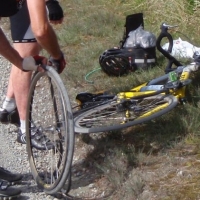One of the most versatile of all lures, the grub mimics baitfish better than almost any other soft plastic bait, and they can be fished many different ways and all year round.
A grub's fat short body and thin twisting tail displaces a tremendous amount of water as it moves along, the bass picks up the vibrations with its lateral lines and movement means food. Once the bass has found the bait its natural shape and color gives him no reason to suspect a trap.
In cold water, winter and early spring, the fish are more sluggish and a slower more deliberate presentation is necessary to fool them. Flipping, and Topwater Grubin' and Shakin' are excellent techniques to catch grub fish this time of year. In the southern most reaches of the west the bass will come into the shallows on warm days, even in winter. Grubs will entice even the most sluggish bass in these conditions.
FLIPPIN'
John Bailey, a Southern California bass fisherman known for his Jig prowess, flips for bass all year long. "In winter and early spring I like to start with the sunny tulle and bulrush areas and the rocky shorelines first." Says John "In our local lakes most of these areas are in less than 7 feet of water and warm up very quickly, the shad seem to find these areas, and where there are shad there are hungry bass." Bailey uses little or no weight, a 3/16oz. slip sinker at most does the job, and Gamakatsu EWG hooks. "I like the slow fall effect that no weight gives me, I just watch the line." John uses 14# test flouro carbon line on a Quantum flipping reel and a 7' Graphite rod. "You need a light line for this technique, but this is no place for 6 or 8# test, the fish will go deep into the tulles the moment he gets the bait so the heavier line helps get his head turned and coming towards me".
Like many West Coast fishermen, John's first lure of choice is the Yamamoto grub, he flips a 4" smoke pepper or smoke sparkle w/blue flake. "Using the slip sinker instead of a heavy jig head it's easier to put it where I want it without making a big splash". If the fish are feeding on smaller shad John switches to a 3" Saturn grub from Phoenix. John points out that it is important to be accurate with your cast But don't disrupt the area if you are wrapped on a reed or deeper into the tulles than you wanted to be. "On those casts that weren't perfect, work the bait where it falls, bass will come get a bait in the strangest places".
"You need to keep your rod in strike position, don't get caught asleep at the wheel" Says Bailey. "Be ready it can happen at any time." I like using a slow lift and fall motion followed by a shake, you need to watch the line closely where it enters the water, if it goes slack before reaching the bottom or twitches, set the hook."
Fishing the outside edges of the wood beds with a small Texas rigged zipper grub is another of Bailey's cold water techniques. John pegs the sinker and works the crawdad colored zipper slowly. If the fish are deep in the wood Bailey uses a crawdad or shad colored, Yamamoto single tail Hula grub. John rigs these on a Gamakatsu football head and crawls it along the bottom near the brush and fallen trees. "You have to be careful hear, I use an exposed hook football head and a miscast will cost you." Says John. "If you get snagged in the trees with these hooks you will either mess up the area getting it loose or lose a $1.50 lure setup." But fishing with John Bailey has taught me a few things, and one thing is sure, the reward is worth the risk.
TOP WATER GRUBBIN'
Every bass angler who has been on the water for any length of time gets excited when he sees flooded timber, it has to hold Bass. But, what are the key elements to decide good timber from great timber. To start with I look for old timber as opposed to green, fresh timber. I am told that new fall or flooded timber leaches sap, and the water quality is not conducive to forage fish. On the other hand the old timber tends to rot. This in turn attracts insects, which attract small forage fish like shad and bluegill, the rest of the food chain follows.
My first target is the flooded timber closest to an old channel or creek bed, If this area has a small feeder creek running into it, all the better. Most fishermen see this area and reach for their spinnerbait or Jig rod. It wouldn't be a wrong choice, a spinnerbait is a great tool for timber, and if you are good with a Jig you will probably pick up some of the more aggressive fish. But next time try a surface grub.
I use a 6' 6" medium action Graphite spinning rod. Tied to the end of the 12# string is a 4" Bass Ripper grub. The long tailed, zipper style grub is rigged Texas with a 2/0 EWG Gamakatsu hook and a pegged 1/16 oz. bullet weight. I like the flat style body of the Bass Ripper because it helps slow the fall and the long flutter tail and small silhouette is very enticing to big bass. Another good choice in a larger profile would be a 5" Yamamoto Grub or a big 6" tube bait.
When fishing a grub in this manner you can be very deliberate and work much slower than a spinnerbait. The twitch and pause method keeps it bait in the strike zone much longer. With the Texas rig and Pegged sinker I can work right over a fallen tree and use the "kill" technique, bass hate this. I can also throw it right into the weeds.
SHAKIN' THAT THING
If your target fish are bunched up in deeper water, you need a different approach. Shaking a grub will entice those sluggish brutes to bite. I like a rod with plenty of backbone but a fast tip for this technique. The key here is light line, I use 8# Trilene XL but any quality line will do. Attach a smaller, crawfish-colored Hula-grub to a fine wire 1/0 or 2/0 hook and a 1/4oz. brass n' glass setup. Rig your bait of choice Texas-style, make sure you push the hook all the way through before skinning the grub with the point.
For fish holding the bottom, position your boat right over the structure, channel break or bait school you are fishing. If you are new to shakin', the principle is quite simple. After the bait reaches the bottom, start shaking the rod tip gently to rattle the brass n' glass. Work the complete structure keeping a light hold with your thumb and index finger to feel for subtle bites. Beware here, not all bites will be subtle, some will be vicious.
For suspended fish the shaking technique is the same, but position your boat slightly up current and cast a shad colored bait past the fish. Most bass pros will tell you that a fish won't go down to get a bait, but most will come up to hit it. When your bait is to the desired depth use a slight lift pause motion while shaking, bringing in just enough of the slack line to stay in the strike zone. The slow fall and natural swimming motion of a grub's tail coupled with that aggravating click of the B & G will entice most suspended fish to attack.
One final note: The key to fishing any of these techniques is persistence, don't give up, stay focused. If your spinnerbait or Jig technique isn't working, try fishing a grub. And if they're still not biting. go somewhere else. And remember, this is supposed to be fun.
THE REACT LURE FOR ALL SEASONS
WINTER: For shallow fish, flip 3-4" grubs, for deeper fish shake 3"single tail or 4" twin Hula-grubs.For suspended fish, match the baitfish,size & color.
SPRING: Try sight fishing a 3" white or glitter grub. for Topwater use a 5 or 7" smoke pepper grub or Tube bait.
SUMMER: For shallow fish go back to flippin, but use a larger 5-7" grub. For inactive fish try a split shot rig on a small 3'' zipper style grub.
FALL: For shallow fish, pitch and flip 4" grubs and for active fish swim or split shot techniques.

ARCCOS Gets A Handle On Your Game


Copyright © www.mycheapnfljerseys.com Outdoor sports All Rights Reserved